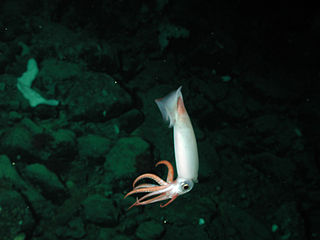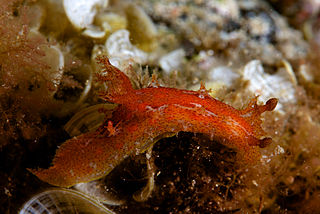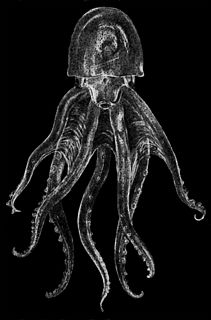
The Noctilucales are an order of marine dinoflagellates. They differ from most others in that the mature cell is diploid and its nucleus does not show a dinokaryotic organization. They show gametic meiosis.

Bioluminescence is the production and emission of light by a living organism. It is a form of chemiluminescence. Bioluminescence occurs widely in marine vertebrates and invertebrates, as well as in some fungi, microorganisms including some bioluminescent bacteria and terrestrial invertebrates such as fireflies. In some animals, the light is bacteriogenic, produced by symbiotic organisms such as Vibrio bacteria; in others, it is autogenic, produced by the animals themselves.

Brachioteuthis is a genus of squid comprising five species.

Chtenopteryx is a genus of small, muscular, midwater squid in the monotypic family Chtenopterygidae. Four species are presently recognized in the genus, but more are believed to exist.

Galiteuthis is a genus of glass squids from the family Cranchiidae and the subfamily Taoniinae. Squids in the genus Galiteuthis are large squids with mantle lengths measuring up to 660mm, although it has been suggested that mantle length could reach as much as 2.7m. The most distinctive feature of the speciesa in this genus are they have hooks on the tentacular clubs while there are no hooks on the arms, and by their long, thin, terminal fins.

Teuthowenia is a genus of glass squid in the subfamily Taoniinae. Members of this genus are characterized by their deep-sea habitat, clear bodies, and ability to engorge themselves with water to become larger when threatened. Each known species has a visible digestive gland, which serves a similar purpose as a stomach and liver.
Mastigoteuthis is a genus of whip-lash squid containing at least seven valid species. Some teuthologists consider Idioteuthis synonymous with this taxon.
Echinoteuthis is a genus of whip-lash squid containing approximately three to five species. Some teuthologists consider Idioteuthis synonymous with this taxon.
Cycloteuthis is a genus of squid in the family Cycloteuthidae. It is distinguished from the genus Discoteuthis by the presence of a tail on the mantle. The species C. akimushkini is currently considered a junior synonym of C. sirventi, however this is inconclusive and the World Register of Marine Species has C. akimushkini as a valid species.
Discoteuthis is a genus of squid in the family Cycloteuthidae. It is distinguished from the genus Cycloteuthis by the absence of a tail on the mantle. The genus occurs in tropical and subtropical oceans worldwide.

Gonatus is a genus of squid in the family Gonatidae, comprising twelve species, and therefore containing the most species in the family. Adult squid belonging to species in this genus are notable for their lack of tentacles.
Siphonosphaera is a genus of radiolarians. The genus contains bioluminescent species. It is a genus of colonial radiolarians.

Plocamopherus is a genus of sea slugs, specifically nudibranchs, shell-less marine gastropod molluscs in the family Polyceridae, subfamily Triophinae. A unique character of Plocamopherus species is a globular bioluminescent organ at the tip of the pair of appendages which are placed just behind the gills. Many species are known to be nocturnal and several are from deep water. They feed on bryozoans.

Vitreledonella is a genus of mesopelagic octopods from the family Amphitretidae which contains two species, one of which is the glass octopus. These octopods have the sucker on their arms arranged in a single series with the suckers widely separated from each other. The third left arm is hectocotylised with a spherical vesicle at the distal end and in males the other arms have suckers which are enlarged beyond the web. The eye has strong lateral compression with a near rectangular shape in lateral view and with the width equal to the diameter of the lens. There is a ventral, blunt rostrum-like extension on the eye which contains iridescent tissue above the eye. The opening to the mantle is broad, the radula is multicuspid and linear in form with the first and second lateral tooth each being unicuspid, which means that this species has a heteroglossan radula. The long and slender digestive gland is spindle-shaped and the stomach is positioned dorsally to the digestive gland.

Japetella is a genus of pelagic octopods from the subfamily Bolitaeninae in the family Amphitretidae. It contains at least one species but another two have been questionably raised with Japetella heathi being of doubtful validity, although currently accepted and Japetella taningi being classed as a nomen dubium.
Collozoum is a radiolarian genus formerly reported in the subfamily Sphaerozoidae, now reported descending from the order Collodaria. The genus contains bioluminescent species. It is a genus of colonial radiolarians.
Sphaerozoum is a radiolarian genus formerly reported in the subfamily Sphaerozoidae, now reported in the Collosphaeridae. The genus contains bioluminescent species. It is a genus of colonial radiolarians.
Acrosphaera is a radiolarian genus in the Collosphaeridae. The genus contains bioluminescent species. It is a genus of colonial radiolarians.
Collosphaera is a radiolarian genus in the family Collosphaeridae. The genus contains bioluminescent species. It is a genus of colonial radiolarians.












